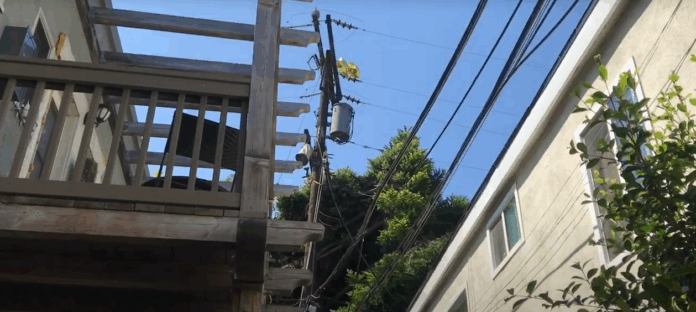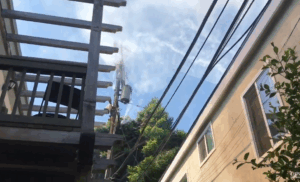Today’s decision could upend California’s phaseout of gas-powered cars and diesel trucks and its decades-long battle against air pollution. California plans to file suit, claiming an unlawful use of an act allowing Congress to review some regulations enacted by the previous administration
por Alejandro Lazo and Alejandra Reyes-Velarde – CalMatters
The U.S. Senate voted today to block California’s landmark mandate phasing out gas-powered cars, dealing a substantial blow to the state’s aggressive transition to electric vehicles.
The decision to revoke three waivers that the Biden administration granted to California could upend the state’s decades-long efforts and authority to clean up its air pollution — the worst in the nation — and reduce greenhouse gases that cause climate change.
Today’s move by the Senate — following a vote in the House last month — sets the stage for what is likely to become a high-stakes legal and political battle between California and the Trump administration.
Republicans in the Senate and some Democrats in the House who voted in favor of blocking California’s electric car mandate — along with two rules cleaning up diesel trucks — said they’re costly and impractical, and prevent consumers and businesses from making their own choices.
But Democrats in the Senate who voted against them, including California’s Alex Padilla and Adam Schiff, said the tactic used by Senate Republicans is illegal and that the state’s mandate is vital to cleaning up polluted air.
California Gov. Gavin Newsom, who has made the adoption of zero-emission cars and trucks a top priority, denounced the move by Congress, vowing that “zero-emission vehicles are here to stay.” Newsom and Attorney General Rob Bonta said at a press briefing today that the state will file suit against the Trump administration.
“We won’t stand by as Trump Republicans make America smoggy again — undoing work that goes back to the days of Richard Nixon and Ronald Reagan — all while ceding our economic future to China. We’re going to fight this unconstitutional attack on California in court,” Newsom said in a statement this morning.
Under California’s mandate, 35 percent of new 2026 model cars sold in the state must be zero-emissions, ramping up to 68 percent in 2030 and 100 percent in 2035. It builds on decades of tightening emissions standards for cars sold in the state.
California officials may now have to rely, at least temporarily, on voluntary efforts to clean up cars and diesel trucks in order to meet federal health standards for smog and soot. For instance, state officials could offer financial incentives or rebates to persuade manufacturers to make electric cars and consumers to buy them. The state, however, faces a $12 billion deficit.
Culminating a late-night, marathon session on Wednesday, the Senate votes highlight the growing political division over electric vehicle and air pollution policy as concerns over cost, charging infrastructure and accessibility prevent many consumers from buying them, even in California, which leads the nation in sales.
For almost 60 years, California’s standards for vehicle emissions have been central to cleaning up its air, particularly in the smoggy Los Angeles basin and San Joaquin Valley. Vehicles are still the largest sources of smog-forming gases and fine particles of soot, which can cause respiratory disorders, heart attacks and other serious and deadly health problems.
Because of its highly polluted air and large population, Congress gave California the power to set its own, more stringent vehicle standards under the 1967 Clean Air Act. But before those standards can take effect, the U.S. Environmental Protection Agency must grant the state a waiver for each one.
Before today, over the past six decades, the EPA and Congress have never blocked any of California’s dozens of car and truck rules. Eleven other states and Washington, D.C. have already adopted a version of California’s electric car mandate, according to the Air Resources Board.
“This is a major blow to the decades-long public health protections delivered under the Clean Air Act,” said Will Barrett, the American Lung Association’s senior director for nationwide clean air advocacy. “It is more important than ever that California and all other states…continue to cut tailpipe pollution through homegrown, health-protective policies.”
Senate Majority Whip John Barrasso, of Wyoming, said Republicans reversed a highly unpopular move by the Biden administration.
“They were losers going out the door and they said ‘we’re coming after you — the American people — with our leftist dreams,’ ” Barrasso said. “This is a whole new meaning in California of fantasy land…America can’t meet these impossible standards, not next year, not in 10 years, and the American people don’t want to meet those standards.”
Sen. Shelley Moore Capito, a Republican from West Virginia, called California’s zero-emission standards for both cars and diesel trucks extreme and a threat to the economy. “I want to be clear, I have no problem with electric vehicles. Consumers should be able to purchase the vehicle of their choice, but I do have a big problem with electric vehicle mandates that replace the will of the consumer and the will of the government,” she said on the Senate floor on Wednesday night.
The Senators mostly voted along party lines. Fifty-one senators voted to rescind the electric car mandate waiver, while 44 voted against it.
“I wonder if any other member of this chamber grew up like I did, where on a pretty regular basis, we would be sent home from grade school because of the intensity and dangers of smog that settled over the San Fernando Valley, the city of Los Angeles,” Padilla said during a Senate session on Tuesday, ahead of the vote.
Schiff said on X Wednesday night that Senate Republicans are “doing the bidding of the oil industry” after Donald Trump promised to help them if they donated $1 billion to his campaign. He said it will mean “Californians and others will be breathing dirtier air, as will others around the country.”
The Senate also in a 51-45 vote today blocked California’s 2020 Advanced Clean Trucks rule, an unprecedented measure that requires manufacturers to meet ramped-up targets for zero-emission heavy and medium-duty trucks for 2024 through 2035. A third vote blocked a 2020 state regulation reducing nitrogen oxides — a key ingredient of smog — emitted by trucks and buses.
President Donald Trump has long opposed California’s unique authority to set its own limits on emissions from cars and trucks. On his first day in office, Trump issued an executive order that aimed to eliminate federal and state electric car regulations and subsidies and restore “consumer choice in vehicles.”
“Trump and his congressional allies have declared war on the environment and this is the first major legislative battle,” said Dan Becker, director of the Center for Biological Diversity’s Safe Climate Transport Campaign.
The Senate action follows an April 30 vote in the U.S. House of Representatives that shocked environmentalists because 35 Democrats joined Republicans to block California’s electric car mandate.
Included were two California House Democrats, both of whom represent districts in the smoggiest part of the state: Rep. Lou Correa of the 46th District in northern Orange County, and newly elected Rep. George Whitesides, from the 27th District in northern Los Angeles County.
“As Americans, we all want to do our part to protect the environment. As a lawmaker, my primary job is to listen to my neighbors and respect their choices to do what is best for their families and their circumstances. That means protecting consumers’ rights to drive whatever vehicle makes sense for them and their pocketbooks,” Correa said in an emailed statement.
California’s mandate has come under fire from auto dealerships and some car manufacturers. Sales of electric cars in the state have undergone a bumpy road.
About 23 percent of all new cars sold in California were zero emissions during the first three months of this year, compared to 25 percent for all of 2024 and 2023, mostly because of a drop in Tesla sales. Californians own 2.2 million zero-emission cars; about 150 models are now sold in the state, 40 percent more than a year ago, according to the California Energy Commission.
John Bozzella, CEO of an alliance of automakers, in a statement today welcomed the move by Congress, saying “these EV sales mandates were never achievable …especially in the coming years when the mandates get exponentially tougher.”
He added, “by the way, the problem really isn’t California. It’s the 11 states that adopted California’s rules without the same level of readiness for EV sales requirements of this magnitude…Again, the concerns were about the mandate – not the technology,” adding that the industry has spent billions developing and manufacturing electric cars.
The Biden administration’s EPA granted the waivers for California’s electric car mandate and nitrogen oxides truck rule late last year, and for the zero-emission truck rule in March 2023. Under the federal Clean Air Act, the EPA can only legally reject a waiver if it’s “arbitrary or capricious,” unnecessary for addressing air pollution or technologically infeasible due to inadequate lead time.
“Congress voted decades ago to allow California, with the nation’s most smog-choked cities, to adopt stronger vehicle air pollution standards,” Becker, a clean-air advocate, said. “This vote will set a dangerous precedent of overturning state law protecting tens of millions in California and 11 other states that have adopted its strong clean air protections.”
Bonta said the state will allege in its lawsuit that it is an unlawful use of the Congressional Review Act.
That law is meant to allow Congress under a new administration to revoke rules recently enacted by the previous administration. But it applies only to regulations, and experts say the waivers are not regulations so they cannot be revoked by Congress. In addition, the three waivers are already in effect, and the diesel truck one was issued more than two years ago, outside the time limits of the review act.
The U.S. Senate’s Parliamentarian and the Government Accountability Office said Congress cannot review Clean Air Act waivers. The Senate voted to evade their Parliamentarian’s ruling in a 51-46 party line, procedural decision on Wednesday night.
UCLA law professor Ann Carlson said Congress is violating its longstanding practices. She called the decision “totally norm-busting.”
“We’re just in a completely new territory,” she said. Congress “seems to be willing to use a statute that doesn’t apply, which is highly unusual. We’ve never seen this before.”
Carlson said by using the Congressional Review Act, lawmakers are seeking to move fast — bypassing the courts and a potential filibuster.
During the first Trump administration, California sued to reverse other actions that blocked air pollution regulations for cars.
Combined, the three regulations targeted by Congress are designed to eliminate tons of soot and gases from cars and diesel trucks that pollute California’s air by requiring manufacturers to switch to cleaner vehicle technologies.
The stakes are high: The state still has some of the worst air pollution in the country, and failure to meet federal health standards for smog and soot could trigger economic penalties, including the loss of highway funding. People in low-income communities of color are particularly exposed to the unhealthiest air.
California is also considered a leader on climate policy, and zero-emission trucks and cars are critical to meeting its targets to phase out nearly all fossil fuels to achieve carbon-neutrality by 2045, which are mandated by state law.
Congress’ repeal of the rules follows an earlier blow to California’s efforts to clean the air. Days before Trump’s inauguration, the state Air Resources Board abandoned two of its groundbreaking standards because Trump’s EPA was unlikely to grant waivers for them.
One of them would have amped up California’s earlier zero-emission truck rule by ending the sale of new diesel trucks in 2036 and requiring large companies to convert their fleets to electric or hydrogen models by 2042.
The other abandoned rule would have required railroads in California to transition new diesel locomotives to ones powered by electricity. Under that rule, only locomotives less than 23 years old could operate in California after 2030 unless they were zero emissions.















